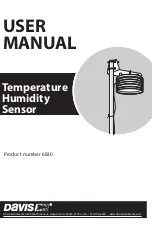
59
TriStar MPPT Operator’s Manual
58
Networking and Communication
Email & SMS Alerts
The email and SMS alerts feature sends notification to an email address or mobile phone if one
of the following occurs:
• TriStar MPPT 150V self diagnostics fault condition
• TriStar MPPT 150V self diagnostics alarm condition
•
User-defined event (e.g. battery voltage is less than 46 Volts)
Up to four email and SMS alerts can be configured from the network settings web page in the
MSView TriStar MPPT 150V wizard.
View Logged Data
The TriStar MPPT 150V logs up to 200 days* of daily data. The controller always logs the stan-
dard values listed below. Using MSView, the controller can be configured to log additional option
-
al values each day. The maximum number of days that can be stored decreases as the number
of logged values increases.
Standard Values
• Minimum Battery Voltage
• Maximum Battery Voltage
• Daily Events (Equalize triggered, Entered Float, Alarm/Fault occurred, Controller Reset)
• Faults / Alarms - recorded only if a fault or alarm occurs that day
Optional Values
• Maximum Array Voltage
• Maximum Power Output
• Charge Amp-hours
• Charge Watt-hours
• Minimum/Maximum Battery Temperature
• Charge stage regulation timers for Absorption, Float, Equalize
* logging only standard values
SNMP
For telecom and industrial applications that require SNMP monitoring of deployed systems, the
TriStar MPPT 150V will behave as an SNMP agent and supports the following commands:
TRAP
GET
GETNEXT
A link to the agent
Management Information Base
file (*.MIB) is available on the
TriStar MPPT 150V Live View
Network Settings
page.
WARNING: RISK OF ELECTRICAL SHOCK.
NO POWER OR ACCESSORY TERMINALS ARE ELECTRICALLY ISOLATED FROM
DC INPUT, AND MAY BE ENERGIZED WITH HAZARDOUS SOLAR VOLTAGE. UNDER
CERTAIN FAULT CONDITIONS, BATTERY COULD BECOME OVER-CHARGED. TEST
BETWEEN ALL TERMINALS AND GROUND BEFORE TOUCHING.
A
VERTISSEMENT: RISQUE DE CHOC ÉLETRIQUE
.
NON ALIMENTATION OU AUX BORNES D’ACCESSOIRES SONT ISOLÉS ÉLEC-
TRIQUEMENT DE L’ENTRÉE DE C.C ET DOIT ÊTRE ALIMENTÉS À UNE TENSION DAN-
GEREUSE SOLAIRE. SOUS CERTAINES CONDITIONS DE DÉFAILLANCE, LA BATTERIE
POURRAIT DEVENIR TROP CHARGÉE. TEST ENTRE TOUTES LES BORNES ET LA MASSE
AVANT DE TOUCHER.
WARNING: Shock Hazard
A means of disconnecting all power supply poles must be provided. These discon-
nects must be incorporated in the fixed wiring. Open all power source disconnects before
removing controller wiring cover, or accessing wiring.
AVERTISSEMENT:
Risque de décharge électrique
Un moyen de déconnexion de tous les poteaux d'alimentation doit être fourni.
Ceux-ci se déconnecte doit être intégrée dans le câblage fixe. Ouvrir que toutes les source
d'énergie se déconnecte avant de retirer le couvercle de la contrôleur, ou accès au câblage.
Battery Charging and Performance Issues
Problem:
No LED indications, controller does not appear to be powered
Solution:
With a multi-meter, check the voltage at the battery terminals on the TriStar MPPT 150V. Battery
voltage must be 8 Vdc or greater. If the voltage on the battery terminals of the controller is be-
tween 8 and 72 Vdc and no LEDs are lit, contact your authorized Morningstar dealer for service.
If no voltage is measured, check wiring connections, fuses, and breakers.
Problem:
The TriStar MPPT 150V is not charging the battery.
Solution:
Check the three (3) battery SOC LEDs. If they are flashing a sequence, see
Section 4.4 Faults &
Alarms
of this manual to determine the issue. If a TriStar Meter 2 is connected, the diagnostics
menu will display reported faults and alarms.
If the LED indications are normal, check the fuses, breakers, and wiring connections in the solar
array wiring. With a multi-meter, check the array voltage directly at the TriStar MPPT 150V solar
input terminals. Input voltage must be greater than battery voltage before charging will begin.
Troubleshooting
6.0








































